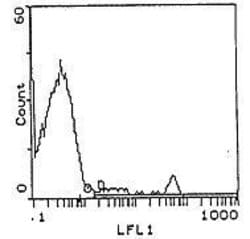Learn More
Invitrogen™ pan T cells Monoclonal Antibody (OX-52), Biotin
Mouse Monoclonal Antibody
Supplier: Invitrogen™ MA517532
Description
Anti-rat pan T lymphocyte monoclonal antibody immunoprecipitates a two chain structure (95, 120 kDa) largely restricted to T lymphocytes and thymocytes. Applications therefore include the identification of T lymphocyte lineage cells in suspension and tissue. The antibody has previously been used to stain T cell areas of the spleen, lymph nodes and Peyer's patch. In the thymus, this antibody labels all thymocytes, however medullary cells are more strongly positive than cortical cells. The antibody does not label such non-lymphoid tissues such as brain, kidney, liver and skin. This antibody stains approximately 1.0% of bone marrow cells, and 56% thoracic duct lymphocytes. Weak staining occurs with 50% dendritic cells from thoracic duct of mesenteric lymphadenectomized rats. The antigen recognized by this antibody is not expressed on granulocytes or macrophages. The function of the antigen recognized by this antibody has not, as yet, been associated with any particular function of T cells. The antibody does not inhibit the allogeneic mixed leukocyte response, nor does it inhibit T cytotoxic effector cell function. This clone works in flow cytometry, Immunoprecipitation and with frozen sections.
Pan T cells, encompassing all T lymphocyte subsets, are integral to the adaptive immune system, originating from hematopoietic stem cells in the bone marrow and maturing in the thymus. These cells include helper T cells (CD4+), cytotoxic T cells (CD8+), regulatory T cells, and memory T cells, each playing distinct roles in immune defense. Pan T cells are characterized by the expression of the T-cell receptor (TCR) complex, which enables antigen recognition and response. The diversity within pan T cells allows for a broad range of functions, from direct cytotoxic effects on infected or malignant cells to regulatory roles in maintaining immune tolerance and memory responses for long-term immunity. These cells also interact with other immune components, enhancing or modulating responses to pathogens and tumors. Pan T cells are pivotal in cancer immunotherapy, where targeting specific T cell subsets can enhance anti-tumor immunity and overcome resistance mechanisms.
Specifications
| pan T cells | |
| Monoclonal | |
| 0.1 mg/mL | |
| PBS with 4-5mg/mL BSA and 0.02% sodium azide | |
| Immunogen:PVG-RT1c thoracic duct lymphocytes and spleen cells. | |
| 500 μg | |
| Primary | |
| Store at 4°C short term. For long term storage, store at -20°C, avoiding freeze/thaw cycles. | |
| Liquid |
| Flow Cytometry, Immunohistochemistry (Frozen) | |
| OX-52 | |
| Biotin | |
| Mouse | |
| Protein G | |
| RUO | |
| Rat | |
| Antibody | |
| IgG2a |
Your input is important to us. Please complete this form to provide feedback related to the content on this product.
